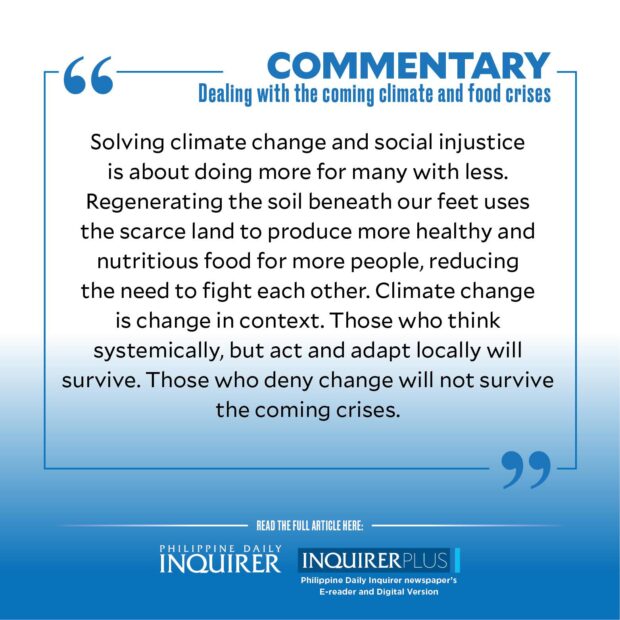Dealing with the coming climate and food crises
After a sizzling summer, the United Nations secretary general has warned that the “era of global boiling has arrived.” What can we do about it?
Climate change is systems change, and we all know it’s tough, if not mission impossible. The pioneering systems thinker and coauthor of the 1972 “The Limits to Growth” report, the late Donella Meadows, argued that a critical way to change complex systems is to find the right leverage point, meaning those small changes that lead to large impact change. So what’s the obvious common factor in climate boiling? The scientific answer is carbon emission. Almost 99 percent of the human body mass comprises six elements: hydrogen, carbon, nitrogen, oxygen, calcium, and phosphorus, with the rest from carbon-containing molecules. Water and carbon dioxide (CO2) are vital in all forms of life.
Article continues after this advertisementAfter humanity learned to till the soil and burn fossil fuels, we accelerated carbon emission and climate warming, melting the global icecaps and the permafrost that holds lots of CO2 and methane, as well as rising sea levels. This vicious cycle threatens our food and water supply, biological diversity, and human existence itself. With shortages of food, water, and energy, wars and human conflict occur, with further damage to the environment, such as the massive war destruction of the Ukrainian farmlands.
So what is the leverage point that we can work on to deal with food, water, and carbon capture? The answer is the soil on which we live, the primary producer of our food and water. The oceans are important in terms of carbon capture and marine food, but the bulk of our population lives on land and relies on food farming. Of the three biospheres, land, ocean, and atmosphere, soil offers the best chance where we can do something about fixing.
Through land mismanagement, more than a third of the world’s soil is already degraded. The Intergovernmental Panel on Climate Change estimated that soil degradation could rise to 90 percent by 2050 if nothing is done. The more degradation, the less food for a growing population.
Article continues after this advertisementMost rural communities grow their own food, but the urban society, which today is more than half of mankind, relies critically on large-scale industrial food production. The 2019 EAT-Lancet Commission “Food in the Anthropocene” report stated: “The human cost of our faulty food systems is that almost 1 billion people are hungry, and almost 2 billion people are eating too much wrong food.” More than 40 percent of adults (2.2 billion people) are now overweight or obese, while 3.1 billion people cannot afford healthy diets.
Increasingly, industrial food production and land is concentrated in very large corporations. Deforestation through clearing of virgin forests leaches the soil since the topsoil with all the inherited nutrients is washed away. At the most basic level, soil comprises complex ecosystems of bacteria, fungi, worms, and microbes that preserve biodiversity, conserve water, and capture carbon. Saving the soil literally saves our future. Recently, there is awareness that a farmer-centric effort to regenerate soil and food production can not only tackle our food crisis, water shortages but also capture carbon. Europe has formed a coalition to explore a farm-centric agriculture regenerative initiative. After being hit by the grain and fertilizer supply shocks arising from the Ukraine war, the developing countries were further alarmed by India limiting the export of rice on July 20 this year. Suddenly food self-sufficiency is now high on the policy agenda, because all politicians are aware that high food prices (inflation) are socially destabilizing.
We should pay more policy attention to domestic farmers and the use of permaculture (regenerative farming practices) that produce crop diversity and regenerate the soil. Indeed, farm practices, such as reforestation that can capture carbon, would create new sources of income from selling carbon credits.
Regenerating the soil, forests, and water sources are social impact projects, as important as public infrastructure, such as transportation, roads, and ports, with high social returns, but low financial rates of return. Even at the city level, vertical farming using organic composts and fertilizers can increase food self-sufficiency to absorb food disruptions.
Is this all pie in the sky? Solving climate change and social injustice is about doing more for many with less. Regenerating the soil beneath our feet uses the scarce land to produce more healthy and nutritious food for more people, reducing the need to fight each other. Climate change is change in context. Those who think systemically, but act and adapt locally will survive. Those who deny change will not survive the coming crises. Asia News Network
—————-
Andrew Sheng is former chair of the Hong Kong Securities and Futures Commission.
—————-
The Philippine Daily Inquirer is a member of the Asia News Network, an alliance of 22 media titles in the region.

















